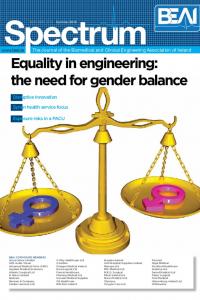Spectrum 2015 Summer
Foreword
Technology and, in particular, medical technology continues to evolve at a fast pace. As clinical engineers, in so far as we can, we work to ensure that healthcare organisations have the best equipment, which works optimally and is used appropriately, to ensure the delivery of effective and safe healthcare. Some of this work is exciting: pushing boundaries, contributing to new research and development. Some is mundane: servicing equipment, carrying out QA procedures and safety testing devices. Within this spectrum, we react to challenges like malfunctioning devices connected to a patient, which must be resolved in minutes or even seconds and we propose new methodologies, working with clinicians to explore the potential of the technology. This guarantees that clinical engineering is never boring. It is always meaningful and it is a profession of which we can be proud. The BEAI will continue to support its members in rising to the challenges of perhaps, the most socially relevant application of technology – medical technology.
As we enter a new BEAI year, this issue of Spectrum introduces our new executive committee. I would like to welcome our new members, and thank those experienced members who have stayed on the committee as well as Paul Lowe and Jonathan Mullen who have stepped down.
We have, of course a busy year planned for the BEAI. Planning for the Annual Scientific Meeting (ASM) on October 2, 2015 is in full swing. We are developing a series of educational events including: electrical safety; an introduction to health economics; an introduction to health technology assessment; and clinical networks as medical devices – this series will be launched at the ASM, and all BEAI members will be offered the opportunity to attend.
The BEAI is also in the process of finalising its Strategic Plan for 2015-2020, which will also be launched at the ASM. We will be running some surveys and a focus group before that. As chairperson of the BEAI, I can guarantee that all feedback will be heard and is welcome.
The BEAI continues to work with the International Federation for Medical and Biological Engineering (IFMBE) and we will be represented at this year’s World Congress in Toronto by Brian Kearney.
Although we have just established our new committee, there is always room for more and our members are all invited to get involved in sub-committees. Just contact any member of the executive committee directly or through the website (www.beai.ie) to express your interest.
Taking a lead from Andrea Fottrell’s article in this issue of Spectrum, I would like to invite all of the women working in clinical engineering to become more involved in the BEAI. We need mná na BEAI.
Meabh Smith
Chairperson BEAI
CONTENTS
3 Editorial
4 News
8 Disruptive innovation – the solution to spiralling health service spend?
11 Syria: dealing with the consequences of violence
14 Staff exposure to waste anaesthetic gases in post-anaesthesia care units
16 Fresenius Medical Care’s new eco-friendly dialysis centre
18 BEAI AGM and Chairman’s Report
21 Roving Reporter
22 HSE national web-based medical device alert system
24 Theatre, post-anaesthetic care unit and recovery, as clinical engineering specialities
26 Women in clinical engineering
28 Assessing asymmetries in the distribution of attention across the whole visual field in unilateral spatial neglect
34 Diary
About Us
The Biomedical / Clinical Engineering Association of Ireland (BEAI) is a company limited by guarantee and not having a share capital. Company Registration no. 484921.
Stay Connected on:
Important Information
Contact Us
For general information, including registration, please contact us at:
- 8 Priory Office Park, Stillorgan Road,
- Blackrock, Co Dublin, Ireland,
- A94 EE95

